The Hidden Costs of Crime Scene Cleaning Most People Don’t Know

When a traumatic event occurs in a home or workplace, the immediate focus is often on the emotional impact and visible damage. However, the cleanup process itself can involve numerous hidden costs that many property owners fail to anticipate. Professional crime scene cleaning goes far beyond simple tidying—it involves specialized equipment, biohazard removal, and meticulous restoration. Understanding these hidden costs can help homeowners and property managers plan more effectively and avoid unexpected financial burdens.
What Is Crime Scene Cleaning?
Crime scene cleaning is a specialized service that removes blood, bodily fluids, and other biohazard materials from affected areas. Unlike standard cleaning, which deals with dirt and debris, crime scene cleaning addresses hazardous contaminants that pose health risks. Professionals are trained to handle biohazards safely, using protective gear, industrial-grade chemicals, and proper disposal techniques. Companies like element pro restoration often combine these services with general property restoration to ensure homes and buildings are fully safe and habitable.
Visible vs. Hidden Costs
Visible Costs
The immediate and obvious costs of crime scene cleanup include:
-
Labor and hourly rates for certified technicians.
-
Specialized cleaning equipment and chemicals.
-
Proper disposal of hazardous waste.
Hidden Costs
What many property owners overlook are the hidden costs, such as:
-
Property Repairs: Carpets, walls, flooring, and furniture may require repair or replacement.
-
Odor and Stain Treatment: Persistent odors or ingrained stains may need repeated or advanced treatment methods.
-
Emotional and Psychological Impact: Traumatic incidents can have a lasting emotional effect, which may require counseling or time off work.
These hidden costs can sometimes exceed the initial cleaning fees, making awareness and planning essential.
Factors Affecting Hidden Costs
Several factors influence the hidden costs of crime scene cleaning:
Size and Complexity
Larger areas or multiple rooms increase the complexity and expense of cleanup. Scenes with multiple biohazard types, such as blood, bodily fluids, or chemicals, require specialized treatment for each material.
Severity and Age of Contamination
Older incidents often present stronger odors and more deeply ingrained stains. Delays in cleanup can also lead to secondary damage, such as mold growth or structural issues.
Property Type and Condition
Residential homes and commercial buildings present different challenges. Older structures may have pre-existing damage that complicates cleanup and increases costs.
Legal and Compliance Costs
Professional crime scene cleaning requires adherence to OSHA, EPA, and local biohazard disposal regulations. Licensed providers must ensure that all work meets these standards to avoid fines or liability. Documenting cleanup for insurance or legal purposes may involve additional inspections, adding to the overall cost. Addressing these requirements proactively ensures compliance and minimizes risk.
Health and Safety Considerations
Exposure to biohazards without proper training can lead to significant health risks, including infections and respiratory issues. Hiring certified professionals protects both property owners and cleanup crews. Protective equipment, containment protocols, and specialized chemicals are necessary to prevent exposure, all of which contribute to hidden costs. In properties that also suffered structural damage from storms, combining cleanup with hail damage restoration can prevent compounded risks.
Long-Term Maintenance and Preventive Costs
After crime scene cleanup, some properties may require ongoing monitoring for odors, mold, or secondary contamination. Air quality treatments, deep sanitation, and preventive maintenance help maintain safety and habitability but can add to long-term costs. Additionally, homeowners should be aware of potential water damage, understanding Causes of Water Damage Ceiling to prevent leaks and ceiling deterioration after a traumatic incident or storm.
Choosing the Right Crime Scene Cleaning Service
Selecting a professional service is critical to managing both visible and hidden costs:
-
Verify certifications, licenses, and insurance coverage.
-
Ensure experience with similar incidents for thorough cleaning.
-
Look for transparent pricing that includes potential extra costs.
-
Consider companies offering comprehensive services, including trauma cleaning services and property restoration, to streamline the recovery process.
How to Minimize Hidden Costs
Property owners can take proactive steps to reduce unexpected expenses:
-
Act promptly to limit contamination severity.
-
Document property damage for insurance purposes before cleanup begins.
-
Use certified professionals who provide upfront estimates and clearly explain potential extra costs.
-
Implement preventive measures, such as repairing structural weaknesses or improving ventilation, to reduce future risks.
Conclusion
Crime scene cleaning involves more than just visible costs. Hidden expenses—including property repairs, odor and stain treatment, legal compliance, and emotional impact can significantly add to the total cost. Hiring certified professionals, like Element Pro Restoration, ensures that cleanup is thorough, safe, and compliant with regulations. Integrating related services, such as hail damage restoration, addressing water damage, and understanding the Causes of Water Damage Ceiling, provides comprehensive care, protecting both property value and the well-being of occupants. Being aware of these hidden costs allows property owners to make informed decisions and achieve effective restoration with peace of mind.
- AI
- Vitamins
- Health
- Admin/office jobs
- News
- Art
- Causes
- Crafts
- Dance
- Drinks
- Film
- Fitness
- Food
- Spellen
- Gardening
- Health
- Home
- Literature
- Music
- Networking
- Other
- Party
- Religion
- Shopping
- Sports
- Theater
- Wellness


